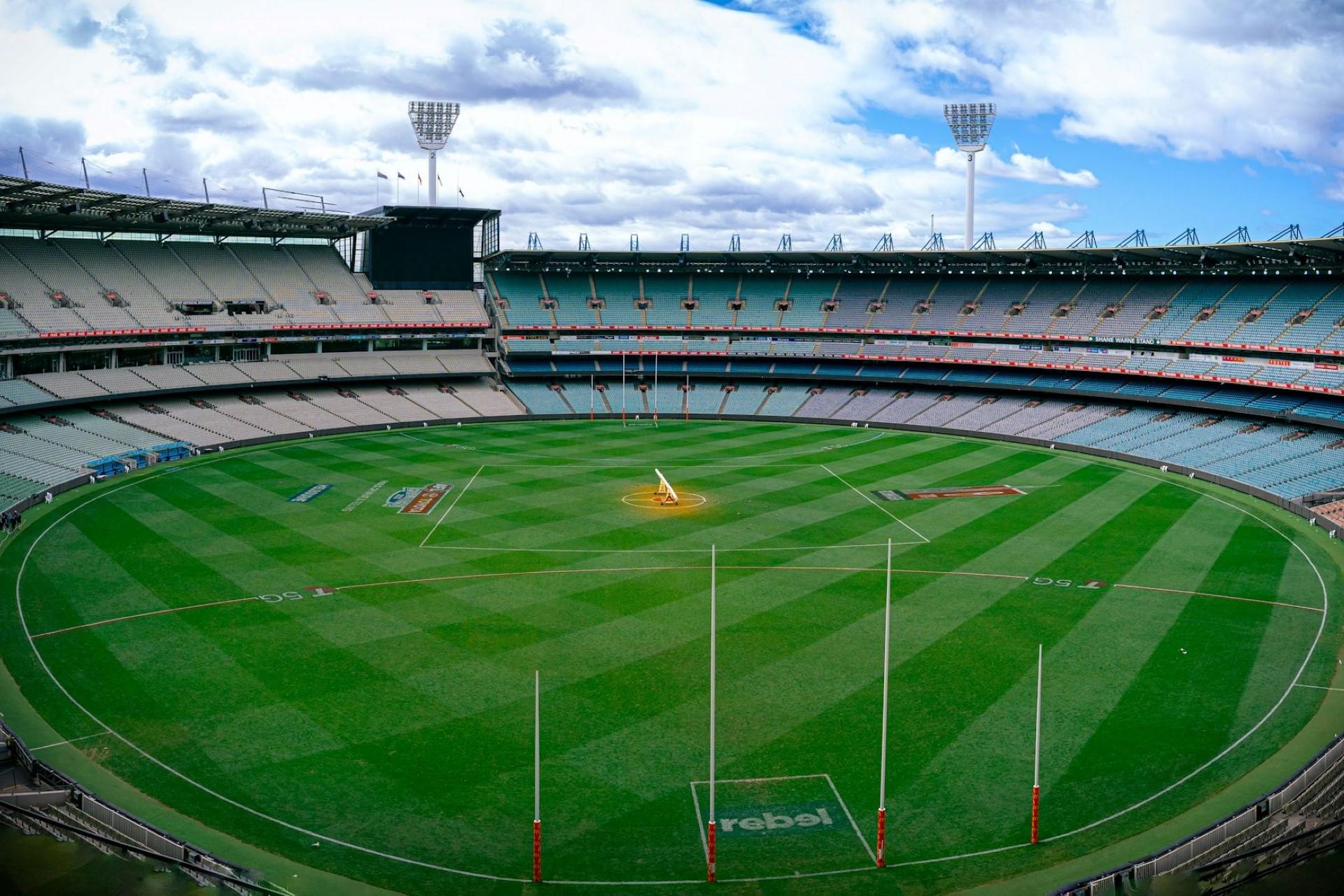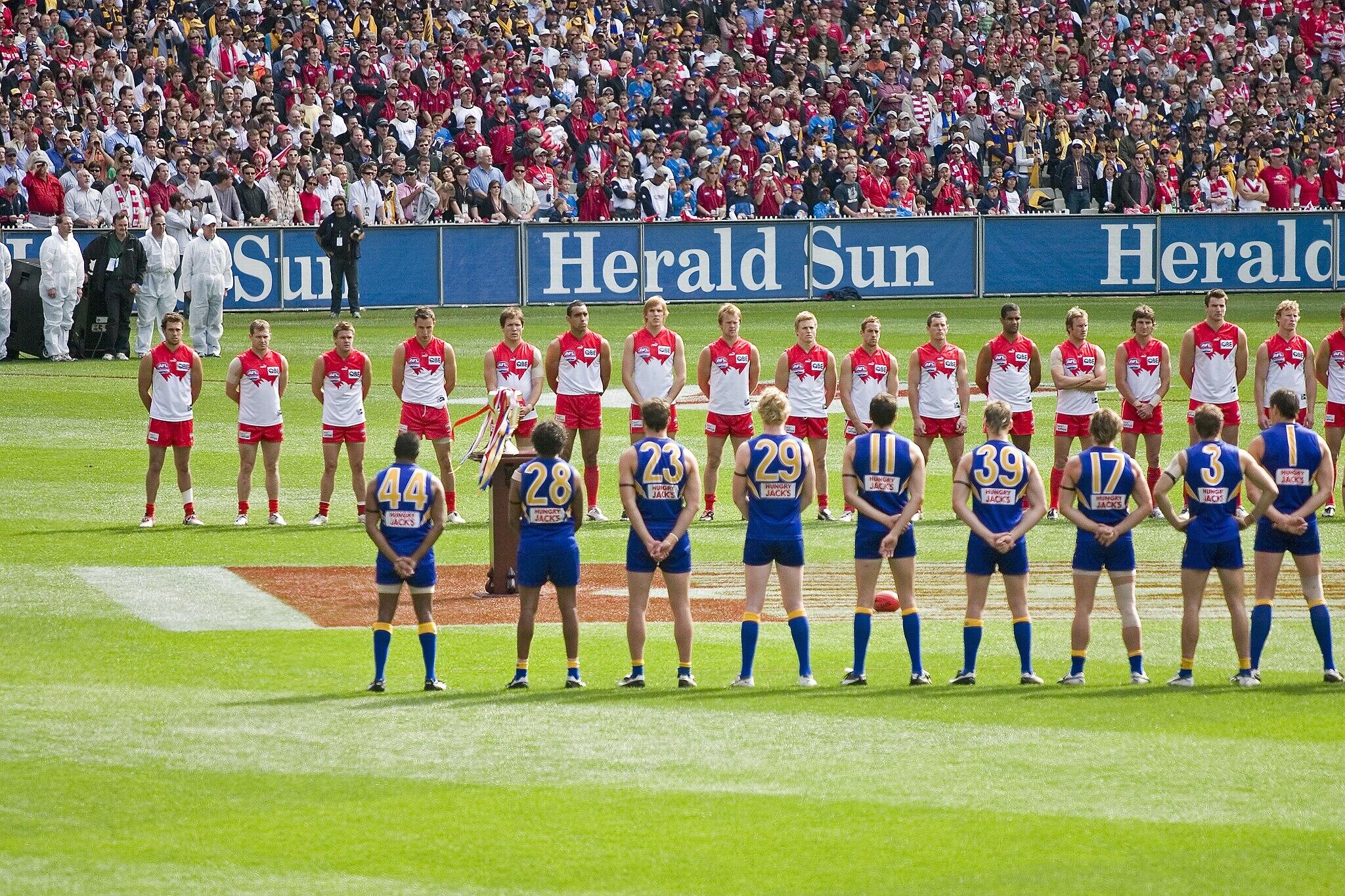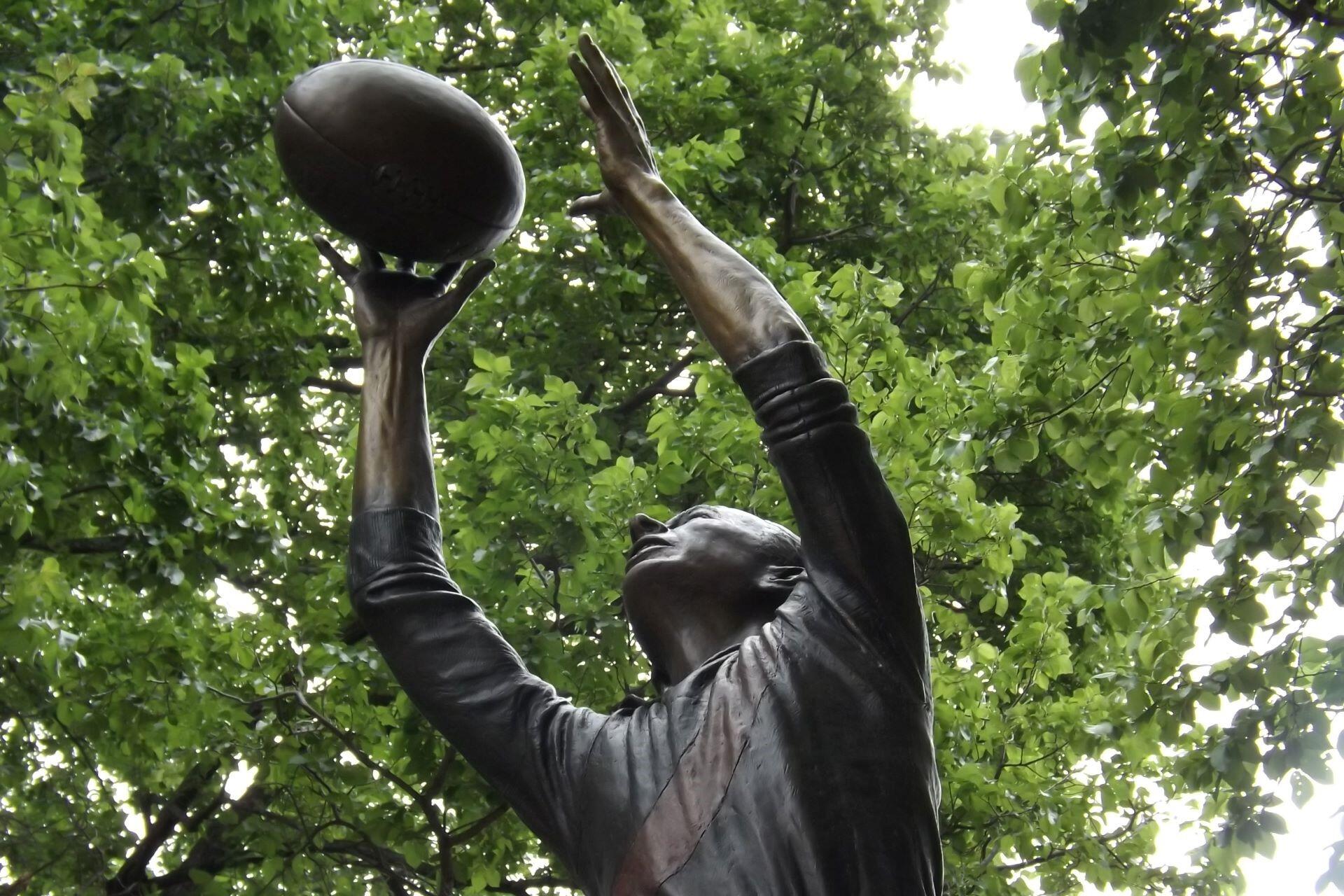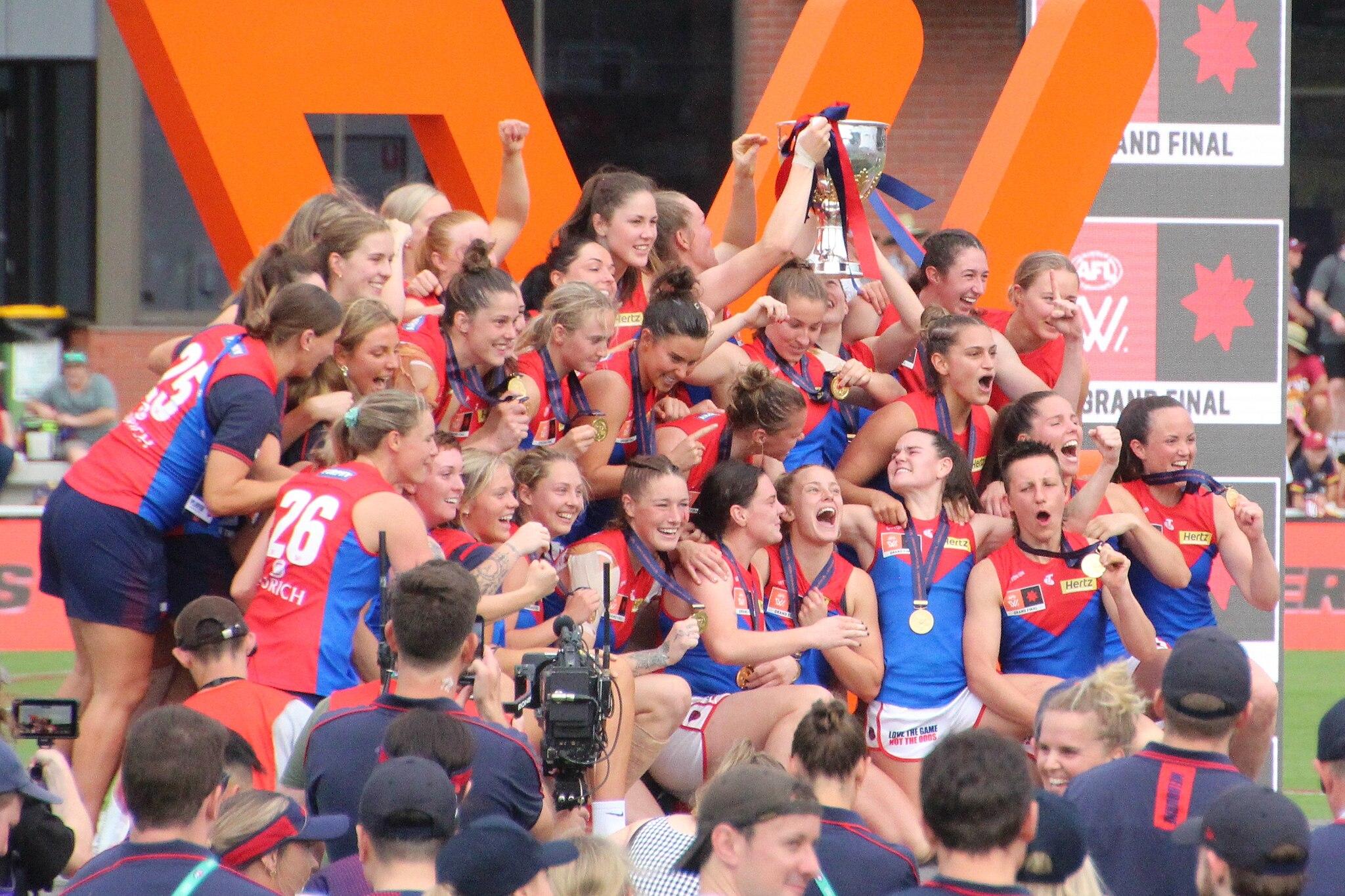Footy, or Aussie rules, is a unique variation of 'football' that stands out among the many versions played worldwide. It combines familiar elements from sports like soccer, rugby, and basketball, yet it has its own distinct rules and gameplay that set it apart from any other sport.
Today, we're going to try to understand what it is and how it all works.

The Basic Rules of the Game
Watching a player with the ball might make footy look like rugby since they can carry it. However, the rules of footy are quite unique.
The Field of Play and Periods of Play
The field of play shouldn't be confused with a soccer pitch or an American football field. Unlike these other sports, a footy field is an oval, not rectangular.

A footy match is played in four 20-minute quarters. Unlike sports like American football, basketball, or ice hockey, the clock isn't stopped for stoppages in play. Instead, Aussie rules uses a stoppage time system like in soccer, with time lost being added onto the end of periods, up to 10 minutes.
After that, time is added on for stoppages.
The Teams
In footy, there are 18 players per team, with four on the bench. This makes for 36 players on the field in total.
Though players are typically divided into defenders, midfielders, and forwards, they're free to move anywhere on the pitch, and the very best AFL players can play in almost any role.
Unlike a quarterback in American football or a goalkeeper in soccer, the players in footy aren't bound by specific rules based on their position. Instead, their positions are more of a strategic moniker, adding an intriguing layer of complexity to the game.
Playing Footy – Attacking
Much like how basketball starts with a jump ball, where the ball is thrown into the air and two players compete for it, footy starts similarly.
Instead of simply throwing the ball up into the air, though, the referee bounces it into the ground, launching it into the air for the players to compete for. This is known as a "centre bounce".
It should be noted that the ball is egg-shaped, similar to that of a rugby ball or an American football. It is not perfectly spherical like a basketball or a soccer ball.
The attacking team attempts to move the ball down the field towards the opponent's end of the field in an attempt to score a goal. We'll explain how scoring works in a moment, but first, we need to explain how players can move the ball.
Running with the Ball
Players can run with the ball in their hands, but they must bounce it every 16 yards (or 15 metres). This is made all the more impressive because the ball isn't spherical, so there's a very particular art to bouncing it so that it bounces back to the player.
Handballing
Players can play the ball forward to their teammates, but they must do this by effectively punching the ball with their first. This is known as a handball, and unlike in soccer, it is not an infringement of the rules.
Kicking
The final way a player can move the ball is by kicking it. When the ball is kicked over 15 metres, a player can jump to catch it, and if they do this right and catch the ball, it's known as a "mark". A mark is extraordinary in Aussie rules because it grants the player a free kick of the ball or the option to continue running with the ball. Whether they "play on" or "stop" and take the unobstructed kick is up to the mark.
What's unique about a mark is that the player leaping into the air can use other players to make the catch. This means that you'll see marks, as they're called, jumping onto the backs of opponents to do it. This is called a "speccy".
A "speccy" or spectacular mark is one of the most exciting parts of Aussie rules. Players leap high into the air, using their opponents to make even higher catches.
This looks like it should be illegal, but it isn't, and that's what makes footy great.
Scoring Points
At the end of the field, there are four posts. Two smaller posts on the outside and two taller posts on the inside.
When a player kicks the ball between the larger of the two posts, they've scored a goal. This is worth six points.
If a ball hits the post or goes outside the taller posts but between one of the larger and smaller posts, it's worth just one point. This is known as a "behind".
When you see a footy score, it's written as goals, behinds, and then the total score.
For example:
- Brisbane: 14.15 (99)
- Carlton: 11.5 (71)
In this footy match, Brisbane scored 14 goals and 15 behinds.
You can calculate the score thus:
- (14 x 6) + 15 = 99.
Similarly, Carlton scored 11 goals and 5 behinds:
- (11 x 6) + 5 = 71.
Basically:
- 6G+B = S where G is goals, B is behinds, and S is score.
You'll hear commentators reading scores simply as the numbers.
For example: “Brisbane fourteen, fifteen, ninety-nine. Carlton eleven, five, seventy-one.”
Goal: 6 points
Behind: 1 point
Playing the Game – Defending
The defending team without the ball constantly tries to stop its opponents from scoring. They can do this in multiple ways.
Tackle
Unlike in American football, where the entire format of the game changes once a tackle is made, footy is a dynamic and fluid game with fewer stoppages in play, keeping the excitement levels high.
Defending players can tackle opponents, provided the tackle is between the shoulders and the knees.
A tackled player must dispose of the ball. Otherwise, this is called "holding the ball", and the opponents get a free kick.
Spoil
A spoil or spoiling occurs when a defending player punches the ball away from a mark attempting to catch it.
Bump
A bump is when players use their body, typically the hips or shoulders, to hit their opponent.
They can do this to dislodge the ball from their opponent, protect their teammates, or disrupt an opponent's movement.
This can only be done in the same legal area for tackling (between the shoulders and knees) and on players contesting the ball.
Smother
A smother is when the defending player attempts to block a kick. This involves lunging or diving towards the opponent as they make the kick, putting themselves in the ball's path.
The timing needs to be perfect, and a good smother typically uses the player's hands, arms, or upper body to block the ball.
Watch this quick explainer video of Aussie rules.
A Brief History of AFL
If you're new to footy, the sport's rules might seem quite different to other sports you're familiar with. However, that's simply due to the history of the sport itself.
So, where did Aussie rules come from, and how did it become the best-attended domestic sports league per capita?
Much like soccer, footy was invented to keep cricket players fit during the winter, when cricket couldn't be played.

It's suggested that the game was inspired by Marn Grook, a popular Indigenous football game played with sometimes over 100 players. The ball in this game was made from a possum skin filled with charcoal.
However, Marn Grook didn't have a scoring system or goals. Instead, it was more about showcasing one's ability with the ball through punting, kicking and catching. In recent footy history, there have been plenty of excellent Aboriginal AFL players.
Early versions of Aussie rules included teams with 26 players on each side. Melbourne Football Club was the first official footy team, but others soon followed.
The first 10 rules of Aussie football were published in 1859, with many lasting into modern footy. These rules included boundaries, handballing, the coin toss, the distance between the goalposts, and marking. They were known as the Melbourne Rules of 1859.
Victoria hosted the earliest days of footy, but it started to spread across Australia, with clubs forming in South Australia and Adelaide, in particular.
By 1866, Aussie rules had reached Queensland and New South Wales, though rugby football remained popular.
The Victorian Football League (VFL) was founded in 1896 and had its inaugural season in 1897. In the 20th century, interstate football games became common, but like many other sports, World Wars I and II brought the sport's growth to a halt.
Aussie rules and rugby remained somewhat geographically separated, with distinct regions where each sport was dominant. However, footie was trying to become a national sport through the VFL.
South Melbourne moved to Sydney and became known as the Sydney Swans in 1982, and then West Coast and Brisbane joined the league. By 1990, the VFL had changed its name to the Australian Football League (AFL), better encapsulating the Australian essence of the sport.
Adelaide, Fremantle, and Port Adelaide had all joined the league by the millennium. Gold Coast and Greater Western Sydney joined in 2011 and 2012, respectively, and the league now has 18 teams in it. Tasmania Football Club became AFL's 19th team and will start competing in the 2028 season.
Here's a great video explaining the entire history of the AFL.
Today, AFL and footy continue to grow, with the highest-earning players earning over $1 million annually. If you're completely new to footy, where have you been?


















